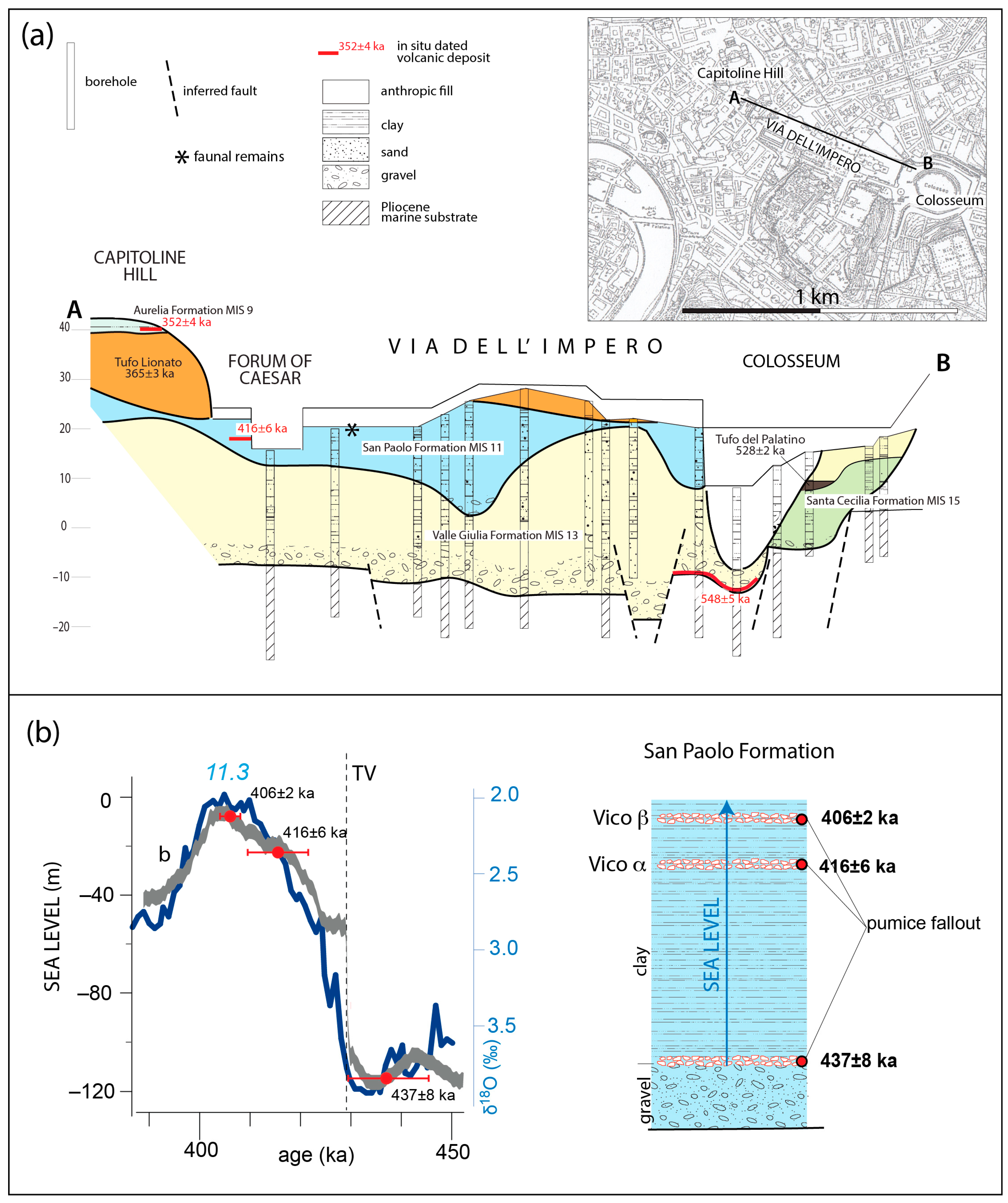Comment on Palombo et al. The Lost MIS 11c Mammalian Fauna from Via dell’Impero (Rome, Italy). Quaternary 2024, 7, 54
Abstract
Conflicts of Interest
References
- Palombo, M.R.; Giaccio, B.; Monaco, L.; Martino, R.; Amanatidou, M.; Pandolfi, L. The Lost MIS 11c Mammalian Fauna from Via dell’Impero (Rome, Italy). Quaternary 2024, 7, 54. [Google Scholar] [CrossRef]
- Karner, D.B.; Renne, P.R. 40Ar/39Ar geochronology of Roman volcanic province tephra in the Tiber River valley: Age calibration of middle Pleistocene sea-level changes. Geol. Soc. Am. Bull. 1998, 110, 740–747. [Google Scholar] [CrossRef]
- Karner, D.B.; Marra, F. Correlation of fluviodeltaic aggradational sections with glacial climate history: A revision of the Pleistocene stratigraphy of Rome. Geol. Soc. Am. Bull. 1998, 110, 748–758. [Google Scholar] [CrossRef]
- Karner, D.B.; Marra, F.; Renne, P.R. The history of the Monti Sabatini and Alban Hills volcanoes: Groundwork for assessing volcanic-tectonic hazards for Rome. J. Volcanol. Geotherm. Res. 2001, 107, 185–219. [Google Scholar] [CrossRef]
- Marra, F.; Deocampo, D.; Jackson, M.D.; Ventura, G. The Alban Hills and Monti Sabatini volcanic products used in ancient Roman masonry (Italy): An integrated stratigraphic, archaeological, environmental and geochemical approach. Earth Sci. Rev. 2011, 108, 115–136. [Google Scholar] [CrossRef]
- Marra, F.; Rohling, E.J.; Florindo, F.; Jicha, B.; Nomade, S.; Pereira, A.; Renne, P.R. Independent 40Ar/39Ar and 14C age constraints on the last five glacial terminations from the aggradational successions of the Tiber River, Rome (Italy). Earth Planet Sci. Lett. 2016, 449, 105–117. [Google Scholar] [CrossRef]
- Marra, F.; Rosa, C.; Silvestri, D.; Bordoni, P.; Bulian, F.; Florindo, F.; Jicha, B.; Cara, F.; Famiani, D.; Salvini, R. Predict: Assessing the Seismic Response in the city of Rome, Part 1. New Data for a Geologic Overview. Ann. Geophys. 2024, 67, SE325. [Google Scholar] [CrossRef]
- Pereira, A.; Monaco, L.; Marra, F.; Nomade, S.; Gaeta, M.; Leicher, N.; Palladino, D.M.; Sottili, G.; Guillou, H.; Scao, V.; et al. Tephrochronology of the central Mediterranean glacial Termination V and MIS 11c (~445–395 ka): New constraints from Vico volcano and Tiber valley, Central Italy. Quat. Sci. Rev. 2020, 243. [Google Scholar] [CrossRef]
- Marra, F.; Rosa, C. Stratigrafia e assetto geologico dell’area romana. In La Geologia di Roma: Il Centro Storico; Funiciello, R., Ed.; Memorie Descrittive della Carta Geologica d’Italia; ISPRA: Rome, Italy, 1995; Volume 50, pp. 49–118. [Google Scholar]
- Luberti, G.M.; Marra, F.; Florindo, F. A review of the stratigraphy of Rome (Italy) according to geochronologically and paleomagnetically constrained aggradational successions, glacio-eustatic forcing and volcano-tectonic processes. Quat. Int. 2017, 438, 40–67. [Google Scholar] [CrossRef]
- Grant, K.M.; Rohling, E.J.; Ramsey, C.B.; Cheng, H.; Edwards, R.L.; Florindo, F.; Heslop, D.; Marra, F.; Roberts, A.P.; Tamisiea, M.E.; et al. Sea-level variability over five glacial cycles. Nat. Commun. 2014, 5, 5076. [Google Scholar] [CrossRef] [PubMed]
- Lisiecki, L.E.; Raymo, M.E. A Pliocene-Pleistocene stack of 57 globally distributed benthic δ18O records. Paleoceanography 2005, 20, PA1003. [Google Scholar] [CrossRef]

Disclaimer/Publisher’s Note: The statements, opinions and data contained in all publications are solely those of the individual author(s) and contributor(s) and not of MDPI and/or the editor(s). MDPI and/or the editor(s) disclaim responsibility for any injury to people or property resulting from any ideas, methods, instructions or products referred to in the content. |
© 2025 by the author. Licensee MDPI, Basel, Switzerland. This article is an open access article distributed under the terms and conditions of the Creative Commons Attribution (CC BY) license (https://creativecommons.org/licenses/by/4.0/).
Share and Cite
Marra, F. Comment on Palombo et al. The Lost MIS 11c Mammalian Fauna from Via dell’Impero (Rome, Italy). Quaternary 2024, 7, 54. Quaternary 2025, 8, 31. https://doi.org/10.3390/quat8020031
Marra F. Comment on Palombo et al. The Lost MIS 11c Mammalian Fauna from Via dell’Impero (Rome, Italy). Quaternary 2024, 7, 54. Quaternary. 2025; 8(2):31. https://doi.org/10.3390/quat8020031
Chicago/Turabian StyleMarra, Fabrizio. 2025. "Comment on Palombo et al. The Lost MIS 11c Mammalian Fauna from Via dell’Impero (Rome, Italy). Quaternary 2024, 7, 54" Quaternary 8, no. 2: 31. https://doi.org/10.3390/quat8020031
APA StyleMarra, F. (2025). Comment on Palombo et al. The Lost MIS 11c Mammalian Fauna from Via dell’Impero (Rome, Italy). Quaternary 2024, 7, 54. Quaternary, 8(2), 31. https://doi.org/10.3390/quat8020031




